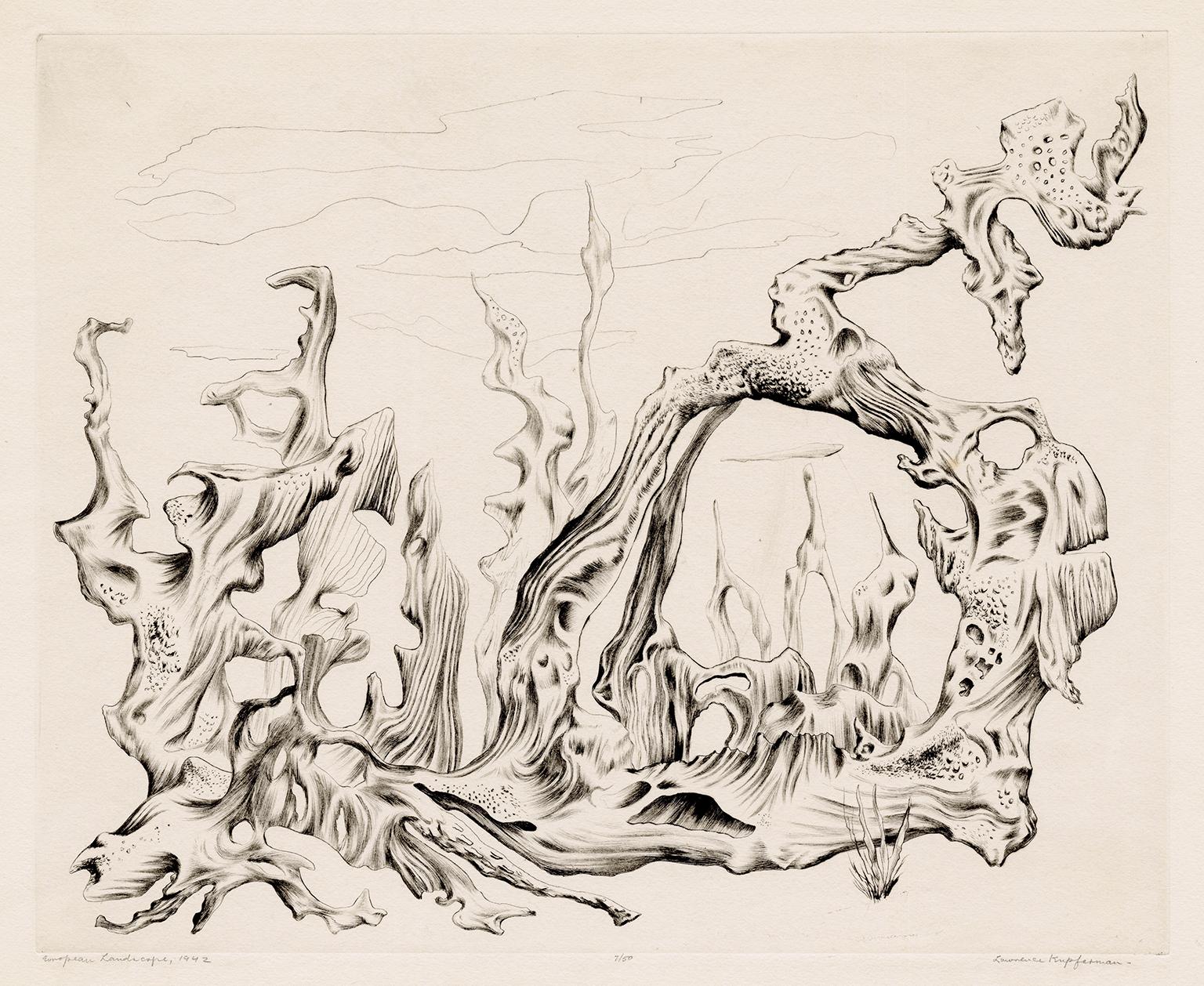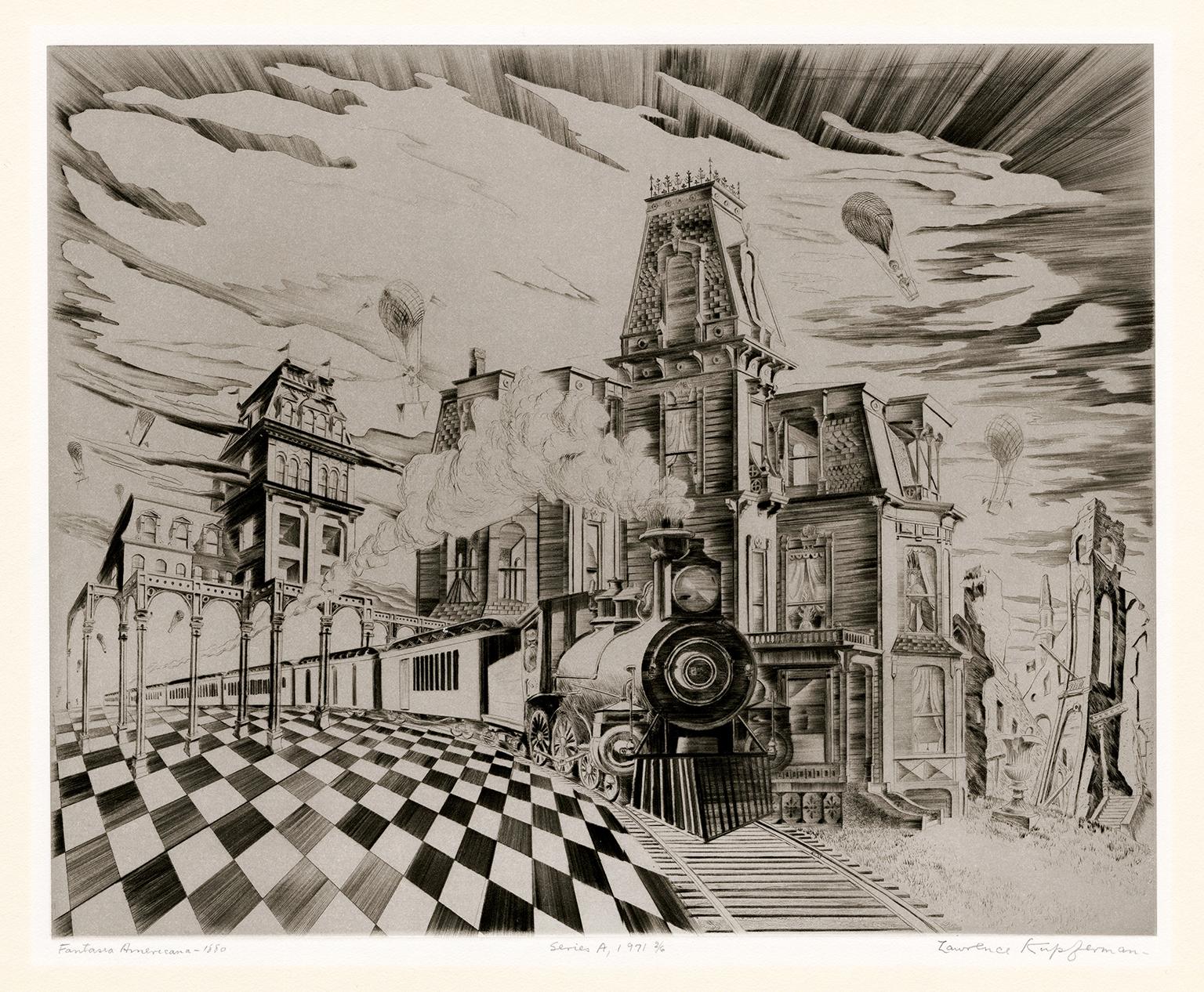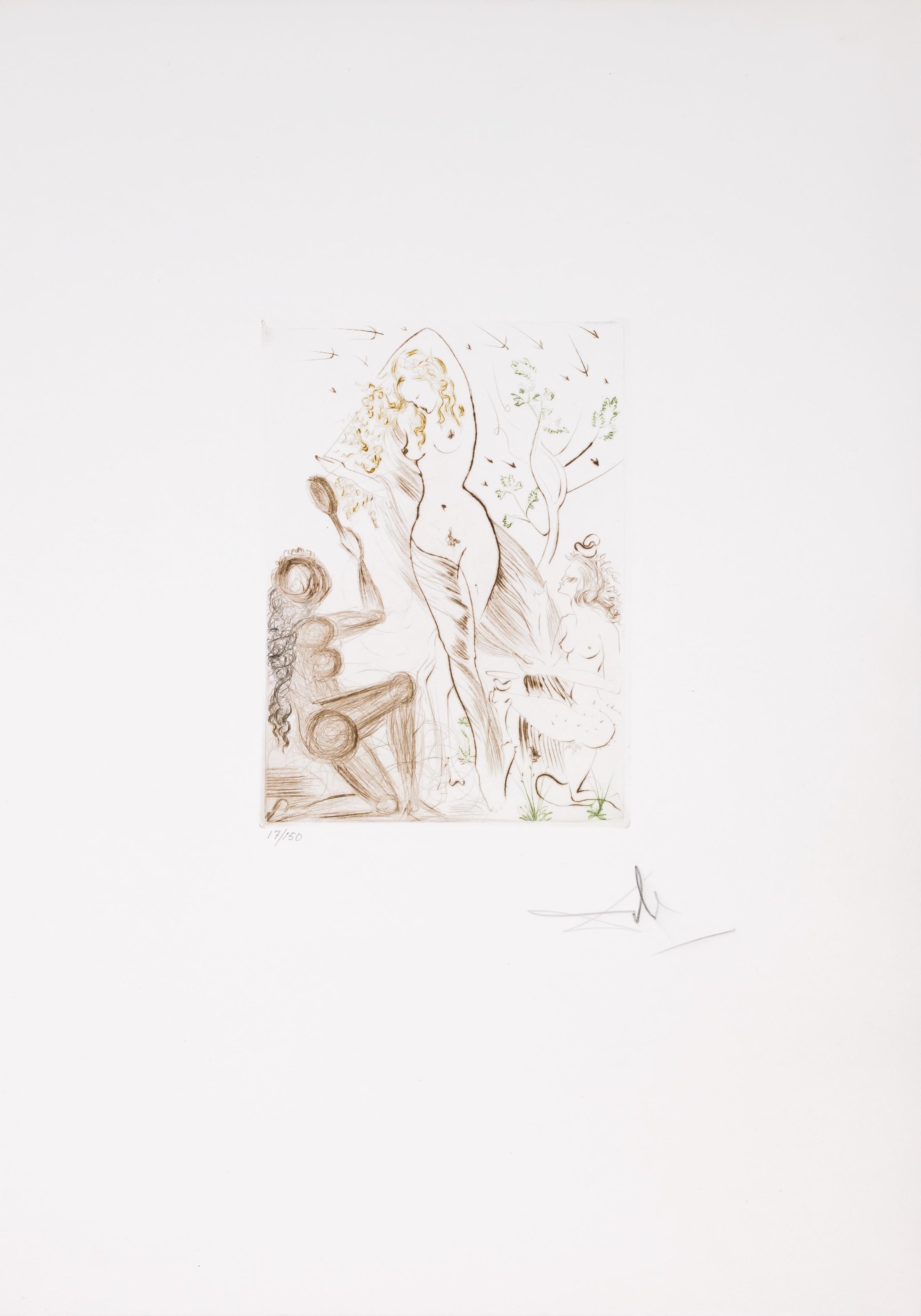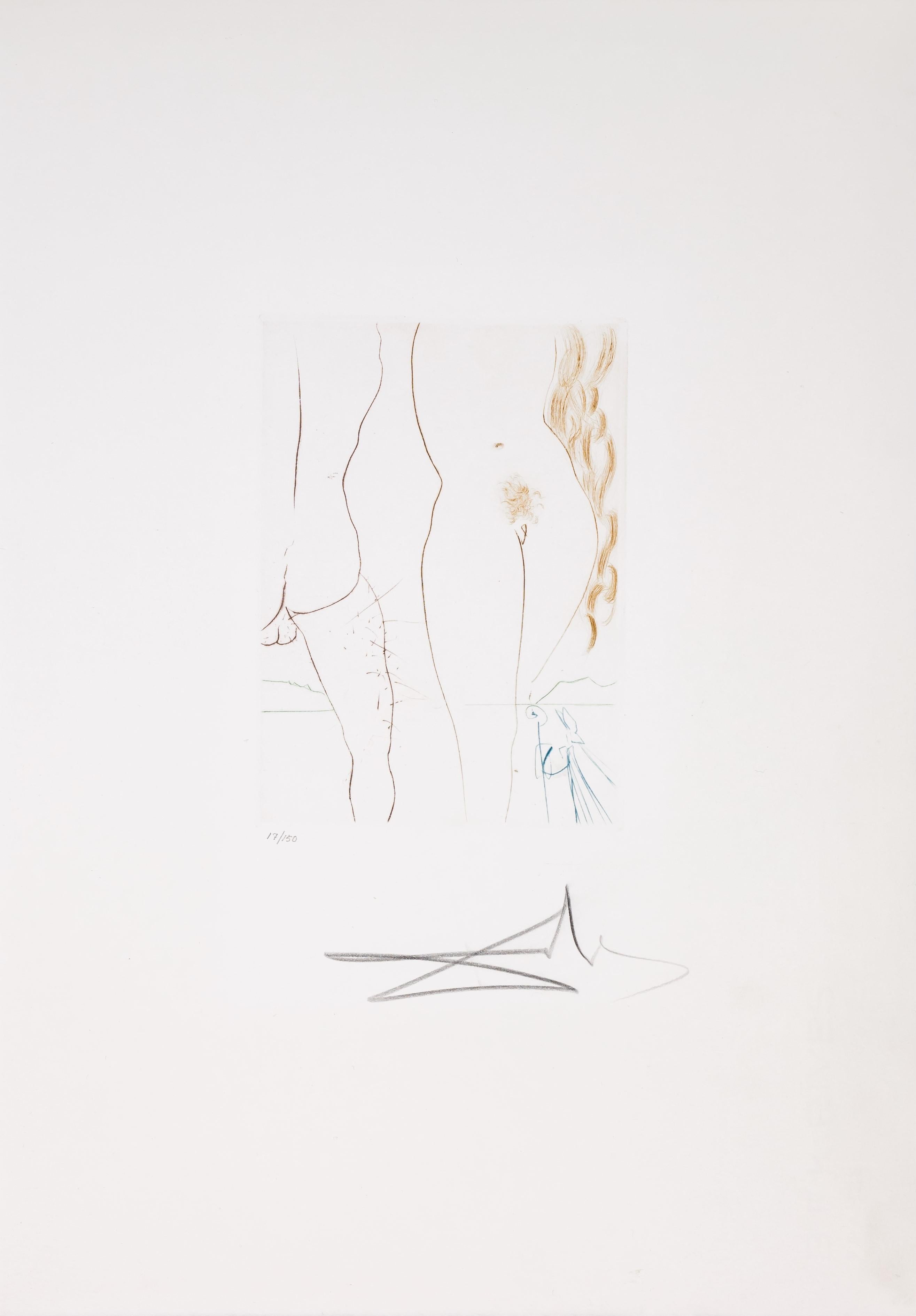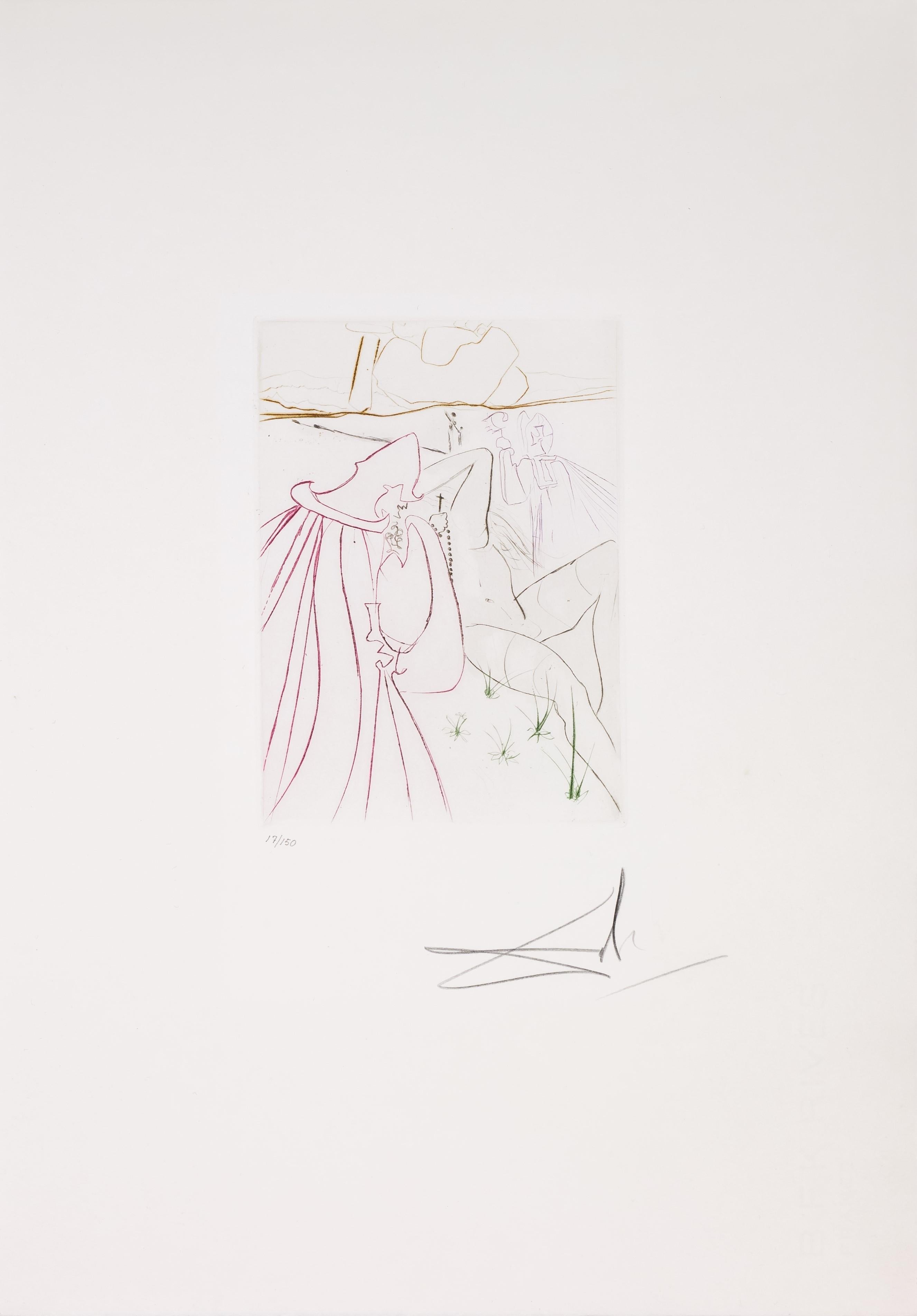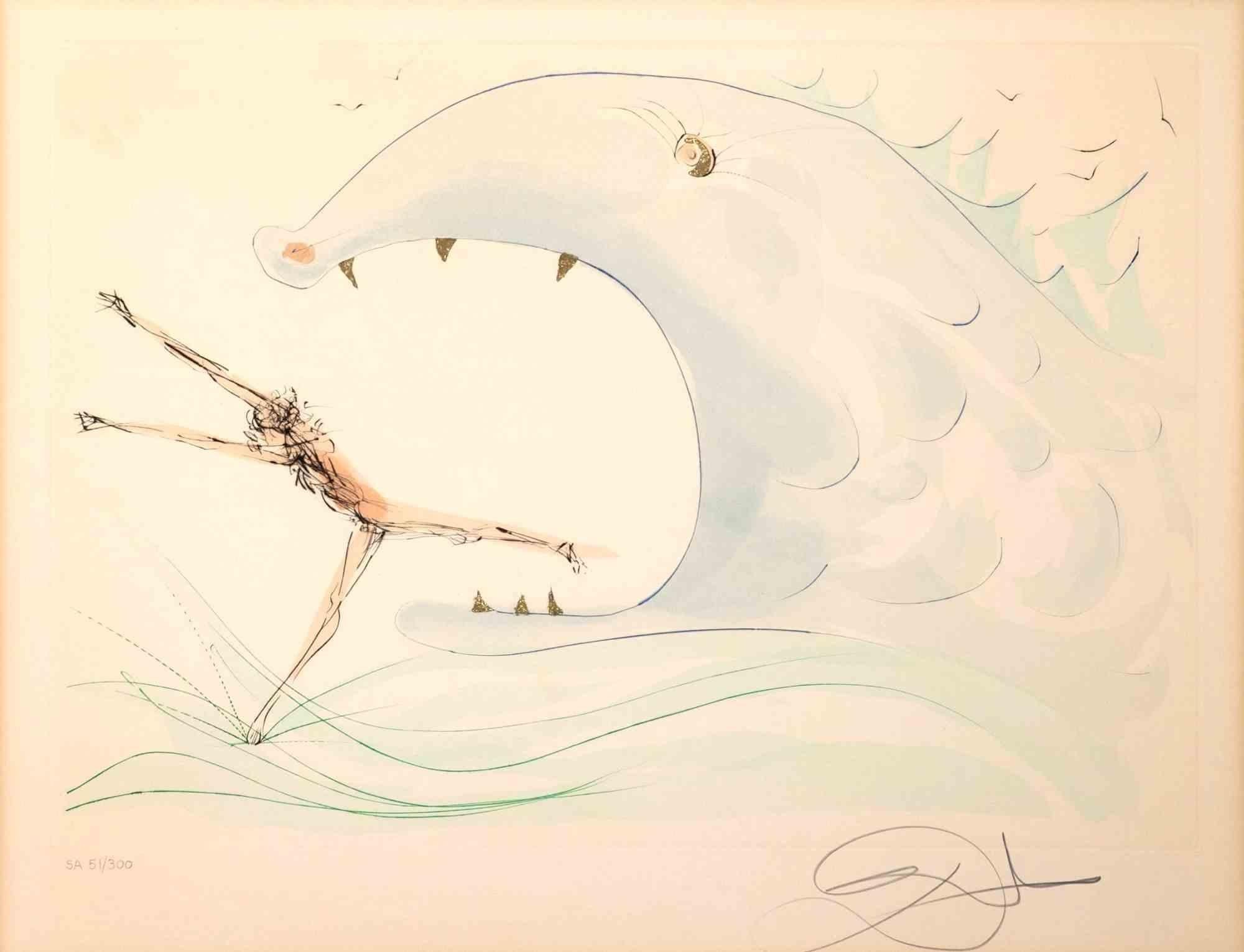Salvador DalíLight Bulb1975
1975
About the Item
- Creator:Salvador Dalí (1904 - 1989, Spanish)
- Creation Year:1975
- Dimensions:Height: 37.5 in (95.25 cm)Width: 29.75 in (75.57 cm)
- Medium:
- Movement & Style:
- Period:
- Condition:
- Gallery Location:Boston, MA
- Reference Number:1stDibs: LU2371170123
Salvador Dalí
Instantly recognizable by his waxed, upturned mustache, the flamboyant Salvador Dalí is one of modern art’s most distinctive figures. He is also one of the icons of the 20-century avant-garde Surrealist movement, whose dreamlike images, drawn from the depths of the unconscious, he deployed in paintings, sculptures, prints and fashion, as well as in film collaborations with Luis Buñuel and Alfred Hitchcock.
Dalí was born in Figueres, Catalonia, and even as a youngster, displayed the sensitivity, sharp perception and vivid imagination that would later define his artworks. In these, he conjured childhood memories and employed religious symbols and Freudian imagery like staircases, keys and dripping candles to create unexpected, often shocking pieces.
Dalí's use of hyperrealism in conveying Surrealist symbols and concepts that subvert accepted notions of reality is epitomized in what is perhaps his most recognizable painting, The Persistence of Memory (1931), in which he depicts the fluidity of time through melting clocks, their forms inspired by Camembert cheese melting in the sun. His artistic genius, eccentric personality and eternal quest for fame made him a global celebrity.
“Each morning when I awake, I experience again a supreme pleasure,” he once said. “That of being Salvador Dalí.”
Find original Salvador Dalí paintings, prints, sculptures and other works on 1stDibs.
- ShippingRetrieving quote...Ships From: Boston, MA
- Return PolicyThis item cannot be returned.
- BustBy Salvador DalíLocated in Boston, MAArtist: Dali, Salvador Title: Bust Series: Faust Date: 1969 Medium: drypoint Framed Dimensions: 22.5" x 18.5" Signature: Pencil signed Edition: 49/145 Literature: AF 50 Provenance: Acquired Directly from the Artist, Private Collection, Palm Beach, FL; DTR Modern GalleriesCategory
1960s Surrealist Prints and Multiples
MaterialsDrypoint
- ZebulonBy Salvador DalíLocated in Boston, MAArtist: Dali, Salvador Title: Zebulon Series: Twelve Tribes of Israel Date: 1972 Medium: drypoint with stenciled color Framed Dimensions: 33" x 27.25" Signature: Pencil signed Edition: XXII/XXXV Literature: AF 78 Provenance: Acquired directly from the Artist, Private Collection, Palm Beach, Fl; DTR Modern GalleriesCategory
1970s Surrealist Prints and Multiples
MaterialsDrypoint
- The Old FaustBy Salvador DalíLocated in Boston, MAArtist: Dali, Salvador Title: The Old Faust Series: Faust Date: 1969 Medium: drypoint Framed Dimensions: 22.5" x 18.5" Signature: Pencil signed Edition: 49 /145 Literature: AF 50 Provenance: Acquired Directly from the Artist, Private Collection, Palm Beach, Fl; DTR Modern GalleriesCategory
1960s Surrealist Prints and Multiples
MaterialsDrypoint
- SatorBy Salvador DalíLocated in Boston, MAArtist: Dali, Salvador Title: Sator Series: Faust Date: 1969 Medium: drypoint with color Framed Dimensions: 22.5" x 18.5" Signature: Pencil signed Edition: 49/145 Literature: AF 50 Provenance: Acquired Directly from the Artist, Private Collection, Palm Beach, FL; DTR Modern GalleriesCategory
1960s Surrealist Prints and Multiples
MaterialsDrypoint
- Meditation Orogenique from PansyBy Salvador DalíLocated in Boston, MAArtist: Dali, Salvador Title: Meditation Orogenique from Pansy Series: Neuf Paysages Date: 1980 Medium: Aquatint and photogravures with black drypoint remarques Framed Dimension...Category
1980s Surrealist Prints and Multiples
MaterialsPhotogravure, Aquatint, Drypoint
- Paysage Avec Figures-SoleilBy Salvador DalíLocated in Boston, MAArtist: Dali, Salvador Title: Paysage Avec Figures-Soleil Series: Neuf Paysages Date: 1980 Medium: Aquatint and photogravures with black drypoint remarques Framed Dimensions: 2...Category
1980s Surrealist Prints and Multiples
MaterialsDrypoint
- 'European Landscape' —Mid-century American SurrealismBy Lawrence KupfermanLocated in Myrtle Beach, SCLawrence Kupferman, 'European Landscape', drypoint, edition 50, 1942. Signed, dated, titled, and numbered '7/50' in pencil. A superb, finely nuanced impression, on cream wove paper; the full sheet with margins (1 to 1 3/4 inches); in excellent condition. Image size 10 7/8 x 13 3/8 inches; sheet size 13 1/8 x 16 1/2 inches. Archivally matted to museum standards, unframed. An impression of this work is included in the permanent collection of the Syracuse University Art Museum. ABOUT THE ARTIST Lawrence Kupferman (1909 - 1982) was born in the Dorchester neighborhood of Boston and grew up in a working-class family. He attended the Boston Latin School and participated in the high school art program at the Museum of Fine Arts, Boston. In the late 1920s, he studied drawing under Philip Leslie Hale at the Museum School—an experience he called 'stultifying and repressive'. In 1932 he transferred to the Massachusetts College of Art, where he first met his wife, the artist Ruth Cobb. He returned briefly to the Museum School in 1946 to study with the influential expressionist German-American painter Karl Zerbe. Kupferman held various jobs while pursuing his artistic career, including two years as a security guard at the Museum of Fine Arts, Boston. During the 1930s he worked as a drypoint etcher for the Federal Art Project, creating architectural drawings in a formally realistic style—these works are held in the collections of the Fogg Museum and the Smithsonian American Art Museum. In the 1940s he began incorporating more expressionistic forms into his paintings as he became progressively more concerned with abstraction. In 1946 he began spending summers in Provincetown, Massachusetts, where he met and was influenced by Mark Rothko, Hans Hofmann, Jackson Pollock, and other abstract painters. At about the same time he began exhibiting his work at the Boris Mirski Gallery in Boston. In 1948, Kupferman was at the center of a controversy involving hundreds of Boston-area artists. In February of that year, the Boston Institute of Modern Art issued a manifesto titled 'Modern Art and the American Public' decrying 'the excesses of modern art,' and announced that it was changing its name to the Institute of Contemporary Art (ICA). The poorly conceived statement, intended to distinguish Boston's art scene from that of New York, was widely perceived as an attack on modernism. In protest, Boston artists such as Karl Zerbe, Jack Levine, and David Aronson formed the 'Modern Artists Group' and organized a mass meeting. On March 21, 300 artists, students, and other supporters met at the Old South Meeting House and demanded that the ICA retract its statement. Kupferman chaired the meeting and read this statement to the press: “The recent manifesto of the Institute is a fatuous declaration which misinforms and misleads the public concerning the integrity and intention of the modern artist. By arrogating to itself the privilege of telling the artists what art should be, the Institute runs counter to the original purposes of this organization whose function was to encourage and to assimilate contemporary innovation.” The other speakers were Karl Knaths...Category
1940s Surrealist Abstract Prints
MaterialsDrypoint
- 'Fantasia Americana - 1880' — Mid-Century American SurrealismBy Lawrence KupfermanLocated in Myrtle Beach, SCLawrence Kupferman, 'Fantasia Americana – 1880', drypoint etching with sandground, 1943. Signed, titled, and annotated 'Series A, 1971 2/6' in pencil. A superb, richly-inked impression, on heavy, cream wove paper, with full margins (2 1/2 to 3 1/2 inches); the paper slightly lightened within the original mat opening, otherwise in excellent condition. One of only 6 impressions printed in 1971, with the added sandground grey background tint. Image size 11 13/16 x 14 3/4 inches; sheet size 18 x 20 1/4 inches. Archivally matted to museum standards, unframed. Collections: National Gallery of Art, Zimmerli Art Museum (Rutgers University). ABOUT THE ARTIST Lawrence Kupferman (1909 - 1982) was born in the Dorchester neighborhood of Boston and grew up in a working-class family. He attended the Boston Latin School and participated in the high school art program at the Museum of Fine Arts, Boston. In the late 1920s, he studied drawing under Philip Leslie Hale at the Museum School—an experience he called 'stultifying and repressive'. In 1932 he transferred to the Massachusetts College of Art, where he first met his wife, the artist Ruth Cobb. He returned briefly to the Museum School in 1946 to study with the influential expressionist German-American painter Karl Zerbe. Kupferman held various jobs while pursuing his artistic career, including two years as a security guard at the Museum of Fine Arts, Boston. During the 1930s he worked as a drypoint etcher for the Federal Art Project, creating architectural drawings in a formally realistic style—these works are held in the collections of the Fogg Museum and the Smithsonian American Art Museum. In the 1940s he began incorporating more expressionistic forms into his paintings as he became progressively more concerned with abstraction. In 1946 he began spending summers in Provincetown, Massachusetts, where he met and was influenced by Mark Rothko, Hans Hofmann, Jackson Pollock, and other abstract painters. At about the same time he began exhibiting his work at the Boris Mirski Gallery in Boston. In 1948, Kupferman was at the center of a controversy involving hundreds of Boston-area artists. In February of that year, the Boston Institute of Modern Art issued a manifesto titled 'Modern Art and the American Public' decrying 'the excesses of modern art,' and announced that it was changing its name to the Institute of Contemporary Art (ICA). The poorly conceived statement, intended to distinguish Boston's art scene from that of New York, was widely perceived as an attack on modernism. In protest, Boston artists such as Karl Zerbe, Jack Levine, and David Aronson formed the 'Modern Artists Group' and organized a mass meeting. On March 21, 300 artists, students, and other supporters met at the Old South Meeting House and demanded that the ICA retract its statement. Kupferman chaired the meeting and read this statement to the press: “The recent manifesto of the Institute is a fatuous declaration which misinforms and misleads the public concerning the integrity and intention of the modern artist. By arrogating to itself the privilege of telling the artists what art should be, the Institute runs counter to the original purposes of this organization whose function was to encourage and to assimilate contemporary innovation.” The other speakers were Karl Knaths...Category
1940s Surrealist Figurative Prints
MaterialsDrypoint, Etching
- Blanchefleur, 1972 (Le Decameron, Plate H)By Salvador DalíLocated in Greenwich, CTBlanchefleur from Dalí's Le Décameron portfolio is a drypoint etching with color on paper, signed Dalí lower right and numbered 17/150 lower left. From the Swedish edition of 150 Ara...Category
20th Century Surrealist Prints and Multiples
MaterialsDrypoint, Etching
- Le Diable en Enfer, 1972 (Le Decameron, Plate C)By Salvador DalíLocated in Greenwich, CTLe Diable en Enfer from Dalí's Le Décameron portfolio is a drypoint etching with color on paper, signed Dalí lower right and numbered 17/150 lower left. From the Swedish edition of 1...Category
20th Century Surrealist Prints and Multiples
MaterialsDrypoint, Etching
- La Ressuscitée, 1972 (Le Decameron, Plate J)By Salvador DalíLocated in Greenwich, CTLa Ressuscitée from Dalí's Le Décameron portfolio is a drypoint etching with color on paper, signed Dalí lower right and numbered 17/150 lower left. From the Swedish edition of 150 A...Category
20th Century Surrealist Prints and Multiples
MaterialsDrypoint, Etching
- Jonas and the Whale - Drypoint - 1975By Salvador DalíLocated in Roma, ITJonas and the whale is an artwork realized in 1975. Drypoint with pochoir on Arches paper, from the Series "Our Historical Heritage". Signed and numbered. Edition SA 51/300. Image 56x40cm - Sheet 66x50.5cm. Ref Michler/Löpsinger 759; Field 75-4 D. Prov. Private Collection France. Very Good condition. Salvador Dalí was an icon of Surrealism, the 20th-century avant-garde movement that sought to release unconscious creative potential through art that featured dreamlike imagery. Dalí's fantastical prints, paintings, sculptures, films, and writing helped cement the movement's identity. Working off psychoanalytic ideas, Dalí rendered fantastical creatures and landscapes that could unsettle and awe. His 1931 canvas The Persistence of Memory...Category
1970s Surrealist Figurative Prints
MaterialsDrypoint
